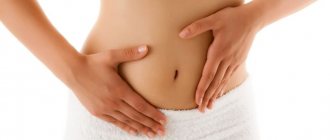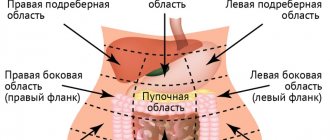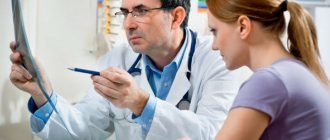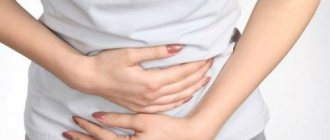Causes and symptoms of pathology
In most cases, pain occurs as a result of disruption of the digestive tract. Unpleasant sensations may occur when:
- gastritis;
- stomach ulcer;
- duodenal ulcer;
- cholecystitis;
- cholelithiasis;
- pyloric stenosis of the esophagus or stomach;
- hiatal hernia
- oncology.
Often the triggers for the appearance of unpleasant sensations in the epigastric area are glomerulonephritis, constipation or diarrhea.
Epigastric pain after eating may be accompanied by other symptoms. For example, if there is an acute form of gastritis, the patient may experience discomfort both on an empty stomach and immediately after eating food. Additionally, attacks of heartburn, nausea or vomiting may occur. The duration of the pain syndrome can fluctuate over different time periods.
When a patient is diagnosed with a chronic form of the disease, the symptoms are less pronounced. Painful sensations often appear precisely at the moment of eating or some time after that. This form of pathology is characterized by frequent disorders of the digestive system. In addition to pain, the patient often experiences heartburn, attacks of nausea, an unpleasant taste in the mouth, and others.
Despite the fact that peptic ulcer is a consequence of previously untreated gastritis, the symptoms of such a pathological process are late in nature. Heaviness in the epigastrium or pain may appear no earlier than 30 minutes after eating. In addition, this disease is characterized by exacerbations, usually in autumn and spring. Due to the production of hydrochloric acid by the stomach, the patient may experience belching with its aftertaste. Other symptoms are similar to gastritis.
After food enters the body, pain due to the presence of a tumor or polyp is almost always absent, but this option should not be excluded.
Irritable stomach syndrome is similar in symptoms to gastritis. The difference is that after eating, the pain persists for several hours. The pathological process does not occur constantly. Poor health alternates with remissions.
Poisoning is another common cause that can cause more than just pain in the epigastric region. Accompanying symptoms may be nausea, fever, loose stools and other signs of pathology.
It is quite difficult to determine the cause of pain without a professional examination by a doctor and a number of certain tests. From the above we can conclude that the symptoms of most pathologies occurring in the digestive organs are similar to each other.
Provoking factors and causes of pain
Why does discomfort occur, and in what ways can it be eliminated? The principles of treatment depend on the factors that provoked the appearance of the pathological symptom.
Among the most common causes of discomfort in the pit of the stomach, doctors include the following:
Developing stomach ulcer
A very likely and dangerous cause of aching pain in the pit of the stomach may be an ulcer on the gastric mucosa. Here you need to pay attention to the following clinical manifestations:
- frequent pain and belching;
- nausea immediately after eating;
- lack of appetite;
- problems with stool (diarrhea, constipation);
- flatulence;
- bloating;
- sour taste in the mouth.
If such factors occur, then it is better to go to the hospital and do an endoscopic analysis of the stomach. Or, as people say, swallow a tube. Alas, this is the only way to identify a stomach ulcer and begin treatment at a more or less early stage.
There is a general principle that allows you to understand even before going to the doctor whether your stomach is bothering you or not. If discomfort occurs immediately after eating, this is a stomach problem. If it hurts before eating, on an empty stomach, and after eating, on the contrary, it goes away, then this is a lesion of the duodenum.
Duodenal ulcer
Aching pain on the right, which radiates to the back, may signal the appearance of an ulcer in the duodenum. The disease is caused by the bacterium Helicobacter Pylori, as in the case of stomach ulcers, but not only it. Additional causes of the disease:
- endocrine disorders;
- unbalanced diet;
- alcohol abuse;
- increased acidity in the gastrointestinal tract;
- too frequent use of antipyretics (Aspirin, Ibuprofen, Nurofen).
The development of ulcers is facilitated by a lack of microelements and vitamins in the body. They take part in redox reactions, the disruption of which can lead to destruction of the duodenal mucosa;
Pancreatitis
Acute constant pain in the epigastrium on the left side is a characteristic symptom of the development of pancreatitis. In the case of an acute course of the disease, it may also be of a shingles nature. Pancreatitis is essentially a malfunction of the pancreas. That is, enzymes for digesting food are not produced, which leads to decay of the duodenal contents. Food is not digested or absorbed by the intestines, which causes nausea and profuse vomiting.
Factors that cause pancreatitis include:
- a large amount of fried, fatty and smoked foods in the diet;
- alcohol abuse;
- long-term use of medications (especially hormonal ones).
Pancreatitis, alas, can be not only an independent disease. Very often it is preceded by the development of a stomach ulcer.
Appendicitis
With appendicitis, pain is first felt in the pit of the stomach, then in the navel, and then moves to the right side. The disease is accompanied by nausea and pain in the right side, which can intensify with deep breathing. As you know, appendicitis cannot be treated with medication; you will need the help of a surgeon.
Lesions of the esophagus
If discomfort in the pit of the stomach on the right is episodic, most likely the symptom is caused by damage to the esophagus, in particular, gastroesophageal reflux. When swallowing, pain radiates to the throat. Factors that provoke diseases of the esophagus are chemical or mechanical damage, inflammation of the ENT organs, and excessive physical activity. If you have such symptoms, you should contact a gastroenterologist.
Methods for solving the problem
Epigastric pain syndrome, which constantly worries the patient and may be accompanied by a number of other unpleasant sensations, must be investigated.
The treatment method will depend on the diagnosis. Therefore, before prescribing a therapeutic course, the doctor must conduct a general examination and give directions for various types of studies of the body.
If the pain that appears immediately after eating is very acute, it is recommended to quickly take the patient to a medical facility or call an ambulance. You should not use any painkillers on your own. The fact is that analgesics will partially or completely relieve pain, and during diagnosis this indicator can distort the results of the initial examination. If an analgesic has been taken, the hospital must inform the doctor about this during the examination.
A prerequisite for successful treatment is adherence to a proper diet. The diet is selected individually.
If treatment is not started in a timely manner, the situation can only get worse. It is possible that if the disease is severe, surgical intervention will be required.
Why does the epigastrium hurt after eating?
Epigastric pain after eating is a fairly common phenomenon that many people experience. Associated clinical signs, as a rule, are the following: increased gas formation, migraine, feeling of heaviness, nausea, vomiting, belching and heartburn. Most often, pathology manifests itself due to improper, irregular nutrition. However, there may be other causes of pain.
Causes of the pathological process
When food enters the stomach, it increases its volume. Heaviness may be felt in the epigastric region due to the active synthesis of gastric juice. This organ actively contracts, as a result of which food moves into the intestine.
Pain in the stomach after eating begins if the digestion process is difficult. Pain in the epigastrium after eating can occur as a result of the impact of food or gastric juice on the lining. Basically, sharp pain in the stomach after eating occurs due to poor nutrition: late dinner, non-compliance with the diet, eating dry food or on the go.
Such symptoms can be observed due to the consumption of hot, sour, fatty, spicy foods. In some cases, the stomach reacts in this way to dry food or excess protein in dishes. Abdominal pain after eating can be the result of individual intolerance to lactose, fructose, sorbitol, alcoholic beverages and other substances. An allergic reaction to some foods causes stomach pain after eating.
Causes of pain in the epigastric region (diseases)
Pain in the epigastrium generally portends any problems in the digestive system. Pain can be divided:
- sharp, sudden pain. Most likely, it is pancreatitis, duodenal ulcer, cholecystitis;
- sharp and sudden. Presumably poisoning or chemical burn;
- sharp and very severe pain, “as if someone were cutting the stomach with a knife.” This is a breakthrough of an ulcer into the abdominal cavity;
- aching pain with a burning sensation indicates gastritis, especially if this occurs after eating;
- pain similar to contractions will indicate inflammation of the intestines or an open ulcer. This may also be an indicator of an intestinal infection;
- pain that feels like a shooting through the epigastrium when changing body position is a consequence of poor blood circulation or an inflammatory process;
- constant aching pain may be a consequence of cancer or polyps;
- dull pain syndrome with pain in the navel area speaks of appendicitis;
- intense pain, which becomes less after 2-3 days, indicates the appearance of colitis.
Let's look at each problem separately.
Gastritis
Gastritis is a common disease in people who eat inconsistently or eat on the run.
Today, more and more often, doctors make this diagnosis to students, office workers and anyone who cannot pamper themselves with normal homemade food, but eats fast food.
To understand whether you have gastritis, just listen to yourself. If there is pain in the epigastrium after eating, you need to consult a gastroenterologist.
Gastritis is inflammation of the stomach lining. It can be divided according to its course into acute and chronic.
The second is scary because of the risks of ulcers and cancerous tumors in the stomach.
There are several types of gastritis, namely: atrophic, erosive, polypous, hypertrophic.
The doctor can accurately determine the type of disease after performing a gastroscopy. During the examination, the doctor, after preparing the patient, inserts an endoscope through the mouth and examines the surface of the esophagus, the area of the stomach and duodenum. The examination must be carried out carefully, because the pathology can be located in different parts of the abdominal cavity.
Pain as a symptom of pathology
When a person regularly has stomach pain after eating, urgent diagnosis and treatment is required. It is important to find out the cause of the pain in time to prevent complications from occurring. Pain after eating, located in the lower abdomen, upper abdomen, or throughout the entire cavity, may indicate the following diseases:
Gastritis
Occurs due to infection entering the gastrointestinal tract or taking non-steroidal anti-inflammatory drugs. Gastritis is characterized by abdominal pain after eating. To cure the disease, you need to consult a gastroenterologist in time.
Peptic ulcer
It has the same symptoms as in the case of gastritis. Manifests itself against the background of long-term therapy for gastritis. When complications develop, the patient is bothered by pain in the right hypochondrium after eating.
Gastric obstruction
This pathology is characterized by pain in the epigastric region, as there is a blockage between the duodenum and the lower stomach. In this case, the lower abdomen hurts. Symptoms occur due to pyloric stenosis, oncology or polyps. Urgent hospitalization and subsequent treatment are required.
Esophageal stenosis
This pathological process is accompanied by headaches, stomach pain, vomiting and nausea after eating. Urgent medical treatment is required.
Hiatal hernia
The symptoms are caused by a protruding part of the stomach, pinching of the diaphragmatic opening. May be accompanied by nausea.
Painful sensations in the stomach can occur for the following reasons:
- pancreatitis;
- cholelithiasis, problems with the spleen;
- cholecystitis - inflammation of the gallbladder;
- ulcer, esophagitis and pathologies of the esophagus;
- diarrhea or constipation;
- inflammatory process localized in the large intestine;
- colitis;
- irritable bowel;
- duodenal ulcer;
- urolithiasis and glomerulonephritis;
- left-sided pyelonephritis.
To avoid exacerbation of the disease, treatment must be started immediately. To determine the type of disease, you should pay attention to the location of the pain, its intensity and the factors that could cause it. If pain is observed after every meal, most likely it signals the presence of a gastrointestinal disease, which a gastroenterologist can determine.
If discomfort bothers you during pregnancy, you should urgently visit a gynecologist or gastroenterologist. For acute pain, call emergency medical help immediately.
Feeling of a lump in the stomach
Gastritis
33327 21 August
IMPORTANT!
The information in this section cannot be used for self-diagnosis and self-treatment.
In case of pain or other exacerbation of the disease, diagnostic tests should be prescribed only by the attending physician. To make a diagnosis and properly prescribe treatment, you should contact your doctor. Feeling of a lump in the stomach: causes of occurrence, what diseases it occurs with, diagnosis and treatment methods.
The feeling of a coma in the stomach is described when one experiences a feeling of heaviness, discomfort and fullness in the stomach, even when it is only slightly filled. Sometimes patients find it difficult to determine the exact location of the coma and point to the lower third of the sternum or solar plexus. In some cases, a feeling of a lump and cramps in the stomach may occur on an empty stomach.
Types of feeling of a coma in the stomach
A feeling of heaviness or coma in the stomach can be an independent symptom, but may be accompanied by other unpleasant sensations. Sometimes it is heartburn, sour belching, bloating, constipation.
In some cases, a feeling of a lump appears when swallowing
, making it difficult for chewed food to pass through.
In addition, patients may complain that food did not enter the stomach, but stopped in the esophagus.
In such patients, vomiting of unchanged food is possible. When describing symptoms, you should pay attention to the time of onset of discomfort - before
or
after eating
.
The patient may feel heaviness in the stomach with pain or heartburn, on an empty stomach or after eating, and night pain also occurs.
Sometimes the sensation of a lump in the stomach occurs
regardless of food intake
.
In such cases, they complain of stomach spasms
, sometimes accompanied by a feeling of a lump in the throat.
What diseases cause a sensation of a lump in the stomach?
Eating more than your usual amount of food
, accompanied by a feeling of fullness and heaviness in the stomach. This condition is not a manifestation of the disease and goes away on its own after some time.
It should be noted that stomach capacity varies depending on eating habits.
People who are small or
have undergone gastric resection
can eat a small portion, otherwise they will not only experience a feeling of heaviness or fullness in the stomach, but also vomiting.
A sensation of coma may occur when consuming foods that cause excess gas.
, as well as
food that is difficult to digest
(salads with mayonnaise, fatty, fried and smoked dishes) and
highly carbonated drinks
.
When eating dry and hastily,
an unpleasant sensation in the epigastric region is caused by poor processing of the food bolus with saliva and insufficient secretion of gastric juice.
However, a feeling of coma or discomfort in the stomach, or more precisely, in the epigastric region, may appear after eating even a small amount of food
.
This condition can be caused by diseases of the gastrointestinal tract or other reasons.
First of all, they assume indigestion, or functional dyspepsia. Its symptoms most often include pain and discomfort immediately after eating, a feeling of heaviness and fullness in the stomach, heartburn, belching, nausea, sometimes vomiting, reflux of stomach contents into the esophagus, bloating and bowel dysfunction.
Dyspepsia can be a symptom of both functional disorders of the gastrointestinal tract and organic diseases.
Functional causes of dyspepsia are often caused by errors in diet and medications.
Iron ions have an irritating effect on the gastric mucosa, which is most pronounced when taking medications based on ferrous iron. Nonsteroidal anti-inflammatory drugs, which are systematically taken for rheumatic and non-rheumatic diseases of the musculoskeletal system, also cause undesirable effects: heaviness and discomfort in the stomach, nausea, vomiting, and dyspeptic disorders.
Neurological disorders
(neuroses, depression), psychological trauma almost always affects the state of the gastrointestinal tract, leading to impaired motility.
Functional dyspepsia is not accompanied by erosive or ulcerative lesions of the stomach; its symptoms disappear when the general state of health is normalized.
One of the common causes of discomfort in the stomach immediately after eating is
gastritis
. It is accompanied by functional and inflammatory processes that have a negative effect on the gastric mucosa. Symptoms of gastritis include heaviness and pain in the stomach, indigestion, nausea, heartburn, sour belching and bloating when eating any food. The inflammatory process leads to atrophy of the mucous membrane and disruption of the glands that secrete gastric juice.
Insufficient gastric juice and weak peristalsis of the stomach and intestines make it difficult to digest food.
Gastritis is often accompanied by dyspepsia. In addition to a feeling of heaviness and aching pain in the epigastric region after eating, poor appetite, weakness, fatigue, and irritability are noted. When pressing on the abdomen, a dull pain appears in the projection of the stomach.
Impaired motor-evacuation functions
upper digestive tract is always accompanied by a feeling of coma or a feeling of heaviness in the stomach. Disorders of esophageal motility are usually caused by incoordination of the esophageal sphincters. Uncoordinated work of the esophageal muscles can lead to a delay in the bolus of food on the way to the stomach, the reflux of food particles into the respiratory tract, and reflux (return of stomach contents into the esophagus). Impaired gastric motility leads to slow emptying, which is accompanied by a feeling of heaviness and fullness even with a small amount of food consumed, pain in the epigastric region, heartburn, nausea and vomiting.
Motility disorders of the esophagus and stomach may be associated with gastroesophageal reflux disease, gastritis, tumors and stenoses (narrowings), metabolic disorders (hyperkalemia, hypercalcemia), postoperative complications of gastrectomy, taking certain medications (opiates, antidepressants, hormones), alcohol and nicotine .
Peristalsis worsens with a sedentary lifestyle and with age.
Stomach cancer can also cause symptoms such as a feeling of heaviness or a lump in the stomach. Moreover, depending on the location of the tumor, its manifestations vary. If the tumor is located closer to the esophagus, problems with swallowing food occur. This is accompanied by increased salivation, nausea, vomiting, and pain in the epigastric region. When the tumor is localized in the lower parts of the stomach, closer to the duodenum, a prolonged feeling of heaviness after eating and bloating is characteristic. When burping, a putrid odor may be felt.
Which doctors should you contact if you feel a lump in your stomach?
If there is a constant feeling of a lump in the stomach or a feeling of heaviness, it is necessary to contact or to make a preliminary diagnosis. The gastroenterologist may also refer the patient to an oncologist. A consultation may also be required.
Diagnosis and examination if you feel a lump in the stomach
First of all, clinical blood and stool tests are necessary for differential diagnosis.
What measures to take
If the listed symptoms and manifestations occur rarely and disappear quickly, you should reconsider your diet. Perhaps the reason for the pain is that you overeat, are in a hurry, abuse fast food, or eat dry food.
A balanced diet will help you get rid of unpleasant symptoms in a short time. Try to normalize your diet: eat small portions, do not skip meals. It is recommended to limit the consumption of heavy and fatty foods and carbonated drinks.
In addition to the basic rules, you must adhere to additional ones, such as:
- transition to fractional meals, its essence is to eat food in small portions, several times a day;
- You can’t not eat anything, if you don’t have an appetite, drink a cup of tea and a cracker or a piece of cheese;
- dinner no later than three hours before bedtime;
- high-quality and fresh dishes should come first and not their quantity;
- you need to give up processed foods and fast food;
- dishes that are difficult to digest should be consumed in small quantities and in the first half of the day;
- It is very useful to take a walk;
- alcohol only in small quantities, and in case of exacerbation it must be completely forgotten;
- You need to constantly drink water, at least one and a half liters per day, but drink water only between meals, on an empty stomach.
Health care
Treatment of stomach pain is associated with neutralizing the effects of gastric and hydrochloric acid. But according to doctors, such a folk remedy as soda should not be used, and there is a possibility of ulcers appearing on the lining of the stomach. In most cases, painkillers are used, such as Nosh-Pa, Almagel, Gastal, antacid suspensions for high acidity.
If your stomach always hurts after eating, then you need to make an appointment with a gastroenterologist or therapist. The doctor will prescribe an examination which consists of:
- general blood test;
- esophagogastroduodenofibroscopy (EFGDS);
- ultrasound examination;
- colonoscopy;
- coprogram (stool examination) and urine test for amylase;
Based on the results obtained, the doctor will prescribe appropriate medications to eliminate this or that pathology.
Pain syndrome, which has a regular acute nature, accompanied by high fever and digestive problems, is a serious signal from the body. Contact your doctor and get examined. Tell your doctor all associated clinical manifestations: vomiting, nausea, flatulence, belching, heartburn, diarrhea, constipation, headaches, weakness and fever. Self-medication and the use of any medications without the knowledge of a doctor are prohibited.
Epigastric region: topographic features
Regio epigastrica or epigastrum is one of the 9 conventional sections into which the abdomen is divided.
To make it easier for clinicians to navigate, it is divided into 3 sections by 2 horizontal lines.
The epigastric region is also called the “episgastric region” or simply “episgastric region”.
Alternatively, the name “epigastric zone” is used.
Its localization: the space between the xiphoid process and the last ribs. It has the shape of a triangle with equal angles.
In the epigastric region there is the “solar plexus” - an area with a large concentration of nerve fibers.
Why does epigastric pain occur?
In the epigastric and hypogastric zones, pain of various types and intensities is present.
Mild pain
are observed after eating; more pronounced ones can occur spontaneously and radiate to the chest, shoulder blade, and neck.
They are caused by inflammatory diseases of the gastrointestinal tract and more.
- Fullness and tingling in the epigastric area indicate a gastric ulcer, hernia, or the presence of stones in the gall bladder.
- The addition of heartburn indicates reflux disease.
- A feeling of heaviness in the abdomen occurs during pregnancy. Fluctuations in hormonal levels affect the state of the gastrointestinal tract: the digestion process slows down, pressure in the abdominal cavity gradually increases. Women have problems with bowel movements.
The most common causes of discomfort in the epigastric region are gastrointestinal pathologies:
- gastritis;
- hepatitis;
- oncology;
- pancreatitis;
- esophagitis;
- volvulus;
- inflammation of appendicitis and its complications;
- ulcerative conditions (perforation, internal bleeding).
It happens that pain in the epigastric region is associated not only with diseases of the digestive tract.
It is also diagnosed when:
- myocardial infarction;
- angina pectoris;
- pneumothorax;
- pleurisy;
- asthma (when there is a chronic cough);
- side effects after taking medications;
- urethritis.
The NetGastritu project was created with the goal of providing people with accurate and up-to-date information on medical topics. Articles are written by professionals and, unfortunately, development costs slow down the development of the project. If you want to support us, use the form below.
Let's make the world a better place together. Thank you for your attention.
The essence of the problem
Heaviness and fullness, accompanied by pain, often bother you after eating. This condition occurs when eating a large amount of food at one time, especially if it is eaten in a hurry.
Food that is not thoroughly chewed and fills the stomach stretches its walls, which disrupts their contractile function, and this, in turn, interferes with the movement of food into the intestines. Stale food is not processed thoroughly by gastric juice, the digestion process is slow and causes heaviness after eating.
Such symptoms often occur against the background of increased gas formation in the intestines, belching, heartburn, indicating an excess of food breakdown products or the development of gastrointestinal diseases.
When complaining of heaviness in the stomach, many note that the feeling of overeating can be disturbing even after a small meal. This means that the functionality of the digestive organs can be impaired due to the influence of both exogenous and endogenous factors.
Why may there be pain in the epigastric region after eating?
Treatment of stomach pain
Despite the fact that today most drugs can be freely purchased at pharmacies, self-medication is still not worth it. Treatment should be carried out according to the diagnosis, and it can only be given by a doctor. For example, a patient suspects that he has gastritis. This disease is divided into types: with high and low acidity. Accordingly, it is necessary to take medications that either lower or increase acidity. Only a doctor can determine the type of gastritis after an examination; the wrong choice of drug will only aggravate the problem.
The gastroenterologist makes the diagnosis based on the examination results. Most often, esophagogastroscopy and ultrasound examination are prescribed. To obtain reliable results, you must exclude coffee and spicy foods from your diet a week before the examination. It is recommended to follow a dairy diet. At night, every day you need to take a laxative prescribed by your doctor. 12 hours before esophagogastroscopy you should refuse food, and 5 hours - from water.
During the examination, a soft tube with a monitor is inserted into the patient's esophagus through the mouth; the mouth and throat are treated with an anesthetic before this to reduce pain during the procedure. The examination lasts from several minutes to half an hour, it depends on the degree of damage to the organ. The doctor carefully examines the stomach lining and, if necessary, takes a tissue sample for a biopsy. Also at this time, the doctor can remove polyps and stop the bleeding.
An ultrasound examination is absolutely painless, but it can only be used to assess the general condition of the mucous membrane; it is impossible to make an accurate diagnosis. If there are gases in the organ, then the examination will not show anything. Therefore, a week before the procedure, you should start eating fermented milk products, porridge with water, and boiled vegetables. If necessary, you can take espumisan, festal, and mezim to combat gas formation. You should abstain from food 12 hours before the ultrasound and 5 hours from water.
Based on the examination results, the doctor prescribes treatment. Antibacterial drugs, drugs that reduce acidity, improve motility, protect the mucous membrane, and others can be prescribed. It is imperative to follow the diet recommended by the doctor; without this, the treatment will not have an effect.
Prevention
The digestive system plays an important role in the functioning of the entire body, so it is better to prevent diseases of the stomach and other digestive organs. It is necessary to eat right, limit the consumption of fried, fatty, spicy and salty foods. You should eat little by little, in small portions, but every few hours, avoiding severe hunger. It is better not to overeat at night - it is recommended to have light foods for dinner. Food needs to be chewed well, there is no need to rush - large pieces can injure the esophagus and stomach, causing irritation and inflammation. Irregular nutrition and consumption of heavy foods are the main causes of the development of many diseases of the digestive system.
Diseases that cause heartburn
In addition to external causes, there are internal factors that provoke the appearance of corresponding symptoms - these are diseases of the gastrointestinal tract (GIT), often associated with excess acidity of the stomach and duodenum.
Gastritis
Gastritis is a disease that develops as a result of a violation of the integrity of the gastric mucosa. The classification of gastritis is quite complex - it can be acute and chronic and is divided into several types, which differ in etiology, course and methods of treatment. The disease appears against the background of hereditary predisposition, bad habits, poor diet, frequent nervous shock, infection of the stomach and other gastrointestinal organs with the bacterium helicobacter pylori.
In addition to heartburn, gastritis is manifested by sharp or aching pain in the stomach, bouts of vomiting, and lack of regular bowel movements. To treat gastritis, medications are used that envelop the surface of the mucous membrane and restore it, and the patient must also adhere to a special diet.
Stomach and duodenal ulcers
Gastric and duodenal ulcers can occur as a complication of gastritis or as an independent ailment. When the disease occurs, defects form in the mucous membrane of the digestive organs in the form of ulcers, which, depending on the type of ulcer, may begin to bleed from time to time. In addition to poor nutrition and Helicobacter pylori infection, intoxication with alcohol, medications, and various chemicals can accelerate the appearance of ulcers. Characteristic signs of the disease are “hunger pain” (a cutting sensation in the stomach area that occurs on an empty stomach), night pain in the stomach and increased appetite. In addition to heartburn, the disease is characterized by symptoms such as sour belching, nausea, and indigestion.
Duodenitis
Duodenitis is an inflammatory disease of the mucous membrane of the duodenum. It is characterized by pain in the pit of the stomach, intensifying some time after eating, and night pain in the stomach. Duodenitis is also characterized by symptoms such as periodic vomiting (bile may be present in the vomit from time to time), constipation, loss of appetite, weight loss, belching, heartburn, a feeling of “fullness” after eating, increased body temperature, and general weakness.
The causes of the disease are most often pathologies of intestinal development, food, medication, chemical poisoning, addiction to spicy foods and alcoholic beverages, and helicobacter pylori. Duodenitis is treated inpatiently, the treatment method is determined by the doctor depending on the factors that provoked it, the severity and form of the disease.
Hiatal hernia
A hiatal hernia (HH) is a relaxation of the muscles of the ligamentous apparatus of the esophageal opening of the diaphragm. The hiatal hernia leads to displacement of the lower part of the esophagus, the upper part of the stomach, and intestinal loops into the chest cavity. The pathology can be caused by old age, uterine pressure during pregnancy, trauma, tumors, frequent hysterical cough, constipation, chronic diseases of the gastrointestinal tract. Symptoms of hiatal hernia include pain that worsens after eating, when lifting heavy objects, during physical activity, difficulty swallowing food, reflux esophagitis, and frequent and severe heartburn.
Gastroesophageal reflux disease
Gastroesophageal reflux disease (reflux esophagitis, GERD) is a disorder of the digestive process in which the contents of the stomach are regularly released into the esophagus. The process contributes to irritation of the walls of the esophagus (less commonly, the larynx), causing a rapid feeling of satiety, burning in the chest area, heartburn and belching. GERD is most often diagnosed in people who are prone to obesity, those employed in hazardous industries, those exposed to constant physical activity, and pregnant women. Additional symptoms that help diagnose GERD are shortness of breath, dry throat, change in voice tone, chronic cough of non-infectious origin.
Achalasia cardia
Achalasia cardia is a disease characterized by a violation of the tone of the opening located between the esophagus and the stomach (cardia). As a result, it loses the ability to open in time when swallowing, and, conversely, can open when it is not necessary. Signs of the disease are difficulty swallowing food, regurgitation, belching, vomiting, and increased salivation.
Additional Information! The disease is dangerous because the hole between the stomach can open at night, during sleep, which will lead to vomiting in an unconscious state.
The situation is fraught with suffocation and even death, so patients diagnosed with achalasia cardia are strongly recommended to sleep exclusively on their sides.
Causes and symptoms of pathology
In most cases, pain occurs as a result of disruption of the digestive tract. Unpleasant sensations may occur when:
- gastritis;
- stomach ulcer;
- duodenal ulcer;
- cholecystitis;
- cholelithiasis;
- pyloric stenosis of the esophagus or stomach;
- hiatal hernia
- oncology.
Often the triggers for the appearance of unpleasant sensations in the epigastric area are glomerulonephritis, constipation or diarrhea.
Epigastric pain after eating may be accompanied by other symptoms. For example, if there is an acute form of gastritis, the patient may experience discomfort both on an empty stomach and immediately after eating food. Additionally, attacks of heartburn, nausea or vomiting may occur. The duration of the pain syndrome can fluctuate over different time periods.
When a patient is diagnosed with a chronic form of the disease, the symptoms are less pronounced. Painful sensations often appear precisely at the moment of eating or some time after that. This form of pathology is characterized by frequent disorders of the digestive system. In addition to pain, the patient often experiences heartburn, attacks of nausea, an unpleasant taste in the mouth, and others.
Despite the fact that peptic ulcer is a consequence of previously untreated gastritis, the symptoms of such a pathological process are late in nature. Heaviness in the epigastrium or pain may appear no earlier than 30 minutes after eating. In addition, this disease is characterized by exacerbations, usually in autumn and spring. Due to the production of hydrochloric acid by the stomach, the patient may experience belching with its aftertaste. Other symptoms are similar to gastritis.
After food enters the body, pain due to the presence of a tumor or polyp is almost always absent, but this option should not be excluded.
Irritable stomach syndrome is similar in symptoms to gastritis. The difference is that after eating, the pain persists for several hours. The pathological process does not occur constantly. Poor health alternates with remissions.
Poisoning is another common cause that can cause more than just pain in the epigastric region. Accompanying symptoms may be nausea, fever, loose stools and other signs of pathology.
It is quite difficult to determine the cause of pain without a professional examination by a doctor and a number of certain tests. From the above we can conclude that the symptoms of most pathologies occurring in the digestive organs are similar to each other.
Associated symptoms
Pain in the epigastric region can be expressed in a single form. However, most often (especially upon closer examination) other symptoms are also present. Among them may be the following:
- unpleasant or painful sensations in the heart area;
- the stomach increases in size;
- the pain begins to radiate to the back or is localized on the right side, and at the same time intensifies;
- there were breathing problems;
- body temperature became above 38;
- it became difficult to swallow even water;
- Blood appeared in feces, urine and vomit.
Attention! If such symptoms are detected in combination with pain in the epigastric region, you should urgently call an ambulance team!
If you experience pain in the epigastrium, first of all you need to consult a therapist.
Methods for solving the problem
Epigastric pain syndrome, which constantly worries the patient and may be accompanied by a number of other unpleasant sensations, must be investigated.
The treatment method will depend on the diagnosis. Therefore, before prescribing a therapeutic course, the doctor must conduct a general examination and give directions for various types of studies of the body.
If the pain that appears immediately after eating is very acute, it is recommended to quickly take the patient to a medical facility or call an ambulance. You should not use any painkillers on your own. The fact is that analgesics will partially or completely relieve pain, and during diagnosis this indicator can distort the results of the initial examination. If an analgesic has been taken, the hospital must inform the doctor about this during the examination.
A prerequisite for successful treatment is adherence to a proper diet. The diet is selected individually.
If treatment is not started in a timely manner, the situation can only get worse. It is possible that if the disease is severe, surgical intervention will be required.











